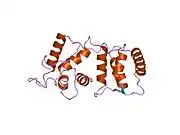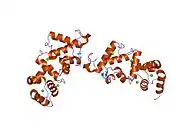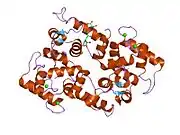CIB1
Calcium and integrin-binding protein 1 is a protein that in humans is encoded by the CIB1 gene and is located in Chromosome 15.[5][6][7] The protein encoded by this gene is a member of the calcium-binding protein family. The specific function of this protein has not yet been determined; however this protein is known to interact with DNA-dependent protein kinase and may play a role in kinase-phosphatase regulation of DNA end-joining. This protein also interacts with integrin alpha(IIb)beta(3), which may implicate this protein as a regulatory molecule for alpha(IIb)beta(3).[7]
Structure and function
CIB1 is a small protein with a molecular weight of approximately 22 kDa. It has a conserved calcium-binding EF hand domain, which consists of two alpha-helices connected by a loop.[8][9] CIB1 also has an integrin-binding domain, located near the N-terminus of the protein. In addition, CIB1 has a coiled-coil domain and a C-terminal domain.[8][10][11] CIB1 is involved in regulating cell adhesion, migration, and differentiation, as well as other cellular processes. It interacts with integrins, which are transmembrane receptors that play a key role in cell signaling and adhesion to the extracellular matrix. CIB1 has also been shown to regulate other signaling pathways that are important for cell survival and proliferation.[8] Upregulation of CIB1 expression has been observed in several types of cancer, and it has been implicated in cancer development and progression.[8] CIB1 is involved in several cellular processes that are important for cancer progression, including cell adhesion, migration, and invasion. It has been shown to interact with integrins, which are transmembrane receptors that play a key role in these processes.[8] The structure and function of CIB1 make it an important protein in regulating various cellular processes, including those involved in cancer progression, and targeting it may offer potential therapeutic benefits.
Cancer
CIB1 expression has been observed in several types of cancer, including breast, lung, prostate, ovarian, and pancreatic cancer. In breast cancer, CIB1 expression has been shown to be higher in invasive ductal carcinoma compared to normal breast tissue.[12] High levels of CIB1 expression have also been associated with poor prognosis in breast cancer patients.[12] CIB1 has been implicated in cancer development and progression. In breast cancer, CIB1 has been shown to promote cell proliferation, migration, invasion, and metastasis.[13] CIB1 has also been shown to promote the growth of prostate cancer cells and the invasion of ovarian cancer cells.[13] Targeting CIB1 has been explored as a potential therapeutic strategy for cancer. Small molecule inhibitors of CIB1 have shown promise in preclinical models of breast cancer. Silencing CIB1 expression has also been shown to sensitize cancer cells to chemotherapy and radiation therapy.[14][13]
Male infertility
CIB1 has been implicated in male fertility, specifically in sperm function and motility.[15] CIB1 expression has been detected in human sperm, and its levels have been correlated with sperm motility. CIB1 has also been shown to be present in the acrosome region of the sperm, which plays a critical role in fertilization. Studies in mice have shown that CIB1 deficiency leads to impaired sperm motility and reduced fertility.[8][15] Male mice lacking CIB1 exhibited decreased sperm count and decreased sperm motility, resulting in reduced fertility. CIB1 was also found to be required for the proper formation of the sperm tail, which is critical for sperm motility.[8] In addition, CIB1 has been shown to regulate calcium signaling in sperm, which is important for sperm motility and fertilization. CIB1 interacts with the sperm-specific calcium channel CatSper, which is important for regulating intracellular calcium levels in sperm.[8]
Spermatogenesis
Spermatogenesis is the process of producing mature spermatozoa from spermatogonia, the precursor cells in the testes. This process involves several stages, including mitotic division, meiotic division, and differentiation, which results in the production of four haploid sperm cells from one diploid spermatogonium. CIB1 has been shown to play a critical role in spermatogenesis by regulating the differentiation of spermatogonia into spermatocytes. Studies have shown that CIB1 is expressed in spermatogonia, spermatocytes, and spermatids, indicating its role throughout the entire process of spermatogenesis.[8][15] In mice, CIB1 deficiency has been shown to lead to decreased spermatogonia proliferation and impaired differentiation into spermatocytes, resulting in reduced sperm production and male infertility.[15] In addition, CIB1 has been shown to regulate the expression of genes involved in spermatogenesis, including genes involved in cell proliferation and differentiation.[8][15]
Interactions
CIB1 has been shown to interact with RAC3,[16] PSEN2,[17] DNA-PKcs,[18] UBR5[19] and CD61.[5]
References
- GRCh38: Ensembl release 89: ENSG00000185043 - Ensembl, May 2017
- GRCm38: Ensembl release 89: ENSMUSG00000030538 - Ensembl, May 2017
- "Human PubMed Reference:". National Center for Biotechnology Information, U.S. National Library of Medicine.
- "Mouse PubMed Reference:". National Center for Biotechnology Information, U.S. National Library of Medicine.
- Naik UP, Patel PM, Parise LV (Apr 1997). "Identification of a novel calcium-binding protein that interacts with the integrin alphaIIb cytoplasmic domain". J Biol Chem. 272 (8): 4651–4. doi:10.1074/jbc.272.8.4651. PMID 9030514.
- Hattori A, Seki N, Hayashi A, Kozuma S, Saito T (Aug 2000). "Genomic structure of mouse and human genes for DNA-PKcs interacting protein (KIP)". DNA Seq. 10 (6): 415–8. doi:10.3109/10425170009015612. PMID 10826701. S2CID 21570442.
- "Entrez Gene: CIB1 calcium and integrin binding 1 (calmyrin)".
- Leisner, Tina M.; Freeman, Thomas C.; Black, Justin L.; Parise, Leslie V. (August 2016). "CIB1: a small protein with big ambitions". The FASEB Journal. 30 (8): 2640–2650. doi:10.1096/fj.201500073R. ISSN 0892-6638. PMC 4970603.
- Kretsinger, R. H.; Nockolds, C. E. (1973-05-10). "Carp muscle calcium-binding protein. II. Structure determination and general description". The Journal of Biological Chemistry. 248 (9): 3313–3326. ISSN 0021-9258. PMID 4700463.
- Blamey, Chad J.; Ceccarelli, Christopher; Naik, Ulhas P.; Bahnson, Brian J. (May 2005). "The crystal structure of calcium- and integrin-binding protein 1: Insights into redox regulated functions". Protein Science. 14 (5): 1214–1221. doi:10.1110/ps.041270805. ISSN 0961-8368. PMC 2253279.
- Huang, Hao; Ishida, Hiroaki; Yamniuk, Aaron P.; Vogel, Hans J. (May 2011). "Solution Structures of Ca2+-CIB1 and Mg2+-CIB1 and Their Interactions with the Platelet Integrin αIIb Cytoplasmic Domain". Journal of Biological Chemistry. 286 (19): 17181–17192. doi:10.1074/jbc.m110.179028. ISSN 0021-9258. PMC 3089561.
- Black, Justin L.; Harrell, J. Chuck; Leisner, Tina M.; Fellmeth, Melissa J.; George, Samuel D.; Reinhold, Dominik; Baker, Nicole M.; Jones, Corbin D.; Der, Channing J.; Perou, Charles M.; Parise, Leslie V. (2015-06-24). "CIB1 depletion impairs cell survival and tumor growth in triple-negative breast cancer". Breast Cancer Research and Treatment. 152 (2): 337–346. doi:10.1007/s10549-015-3458-4. ISSN 0167-6806. PMC 4516161.
- Liu, Yuanqi; Zhou, Yanwu; Zhang, Pengfei; Li, Xizhe; Duan, Chaojun; Zhang, Chunfang (March 2021). "CHIP-mediated CIB1 ubiquitination regulated epithelial–mesenchymal transition and tumor metastasis in lung adenocarcinoma". Cell Death & Differentiation. 28 (3): 1026–1040. doi:10.1038/s41418-020-00635-5. ISSN 1476-5403. PMC 7937682.
- Qin, Xuying; Sun, Linlin; Wang, Jing (2017-08-17). "Restoration of microRNA-708 sensitizes ovarian cancer cells to cisplatin via IGF2BP1/Akt pathway". Cell Biology International. 41 (10): 1110–1118. doi:10.1002/cbin.10819. ISSN 1065-6995.
- Yuan, Weiping; Leisner, Tina M.; McFadden, Andrew W.; Clark, Shantres; Hiller, Sylvia; Maeda, Nobuyo; O'Brien, Deborah A.; Parise, Leslie V. (2006-11-01). "CIB1 Is Essential for Mouse Spermatogenesis". Molecular and Cellular Biology. 26 (22): 8507–8514. doi:10.1128/mcb.01488-06. ISSN 1098-5549. PMC 1636792.
- Haataja, Leena; Kaartinen Vesa; Groffen John; Heisterkamp Nora (Mar 2002). "The small GTPase Rac3 interacts with the integrin-binding protein CIB and promotes integrin alpha(IIb)beta(3)-mediated adhesion and spreading". J. Biol. Chem. 277 (10): 8321–8. doi:10.1074/jbc.M105363200. ISSN 0021-9258. PMID 11756406.
- Stabler, S M; Ostrowski L L; Janicki S M; Monteiro M J (Jun 1999). "A myristoylated calcium-binding protein that preferentially interacts with the Alzheimer's disease presenilin 2 protein". J. Cell Biol. 145 (6): 1277–92. doi:10.1083/jcb.145.6.1277. ISSN 0021-9525. PMC 2133148. PMID 10366599.
- Wu, X; Lieber M R (Oct 1997). "Interaction between DNA-dependent protein kinase and a novel protein, KIP". Mutat. Res. 385 (1): 13–20. doi:10.1016/s0921-8777(97)00035-9. ISSN 0027-5107. PMID 9372844.
- Henderson, Michelle J; Russell Amanda J; Hird Samantha; Muñoz Marcia; Clancy Jennifer L; Lehrbach Gillian M; Calanni Sophina T; Jans David A; Sutherland Robert L; Watts Colin K W (Jul 2002). "EDD, the human hyperplastic discs protein, has a role in progesterone receptor coactivation and potential involvement in DNA damage response". J. Biol. Chem. 277 (29): 26468–78. doi:10.1074/jbc.M203527200. ISSN 0021-9258. PMID 12011095.
Further reading
- Wu X, Lieber MR (1997). "Interaction between DNA-dependent protein kinase and a novel protein, KIP". Mutat. Res. 385 (1): 13–20. doi:10.1016/s0921-8777(97)00035-9. PMID 9372844.
- Seki N, Hayashi A, Abe M, et al. (1999). "Chromosomal assignment of the gene for human DNA-PKcs interacting protein (KIP) on chromosome 15q25.3-q26.1 by somatic hybrid analysis and fluorescence in situ hybridization". J. Hum. Genet. 43 (4): 275–7. doi:10.1007/s100380050089. PMID 9852683.
- Stabler SM, Ostrowski LL, Janicki SM, Monteiro MJ (1999). "A myristoylated calcium-binding protein that preferentially interacts with the Alzheimer's disease presenilin 2 protein". J. Cell Biol. 145 (6): 1277–92. doi:10.1083/jcb.145.6.1277. PMC 2133148. PMID 10366599.
- Kauselmann G, Weiler M, Wulff P, et al. (1999). "The polo-like protein kinases Fnk and Snk associate with a Ca(2+)- and integrin-binding protein and are regulated dynamically with synaptic plasticity". EMBO J. 18 (20): 5528–39. doi:10.1093/emboj/18.20.5528. PMC 1171621. PMID 10523297.
- Hwang PM, Vogel HJ (2000). "Structures of the platelet calcium- and integrin-binding protein and the alphaIIb-integrin cytoplasmic domain suggest a mechanism for calcium-regulated recognition; homology modelling and NMR studies". J. Mol. Recognit. 13 (2): 83–92. doi:10.1002/(SICI)1099-1352(200003/04)13:2<83::AID-JMR491>3.0.CO;2-A. PMID 10822252. S2CID 42776144.
- Holtrich U, Wolf G, Yuan J, et al. (2000). "Adhesion induced expression of the serine/threonine kinase Fnk in human macrophages". Oncogene. 19 (42): 4832–9. doi:10.1038/sj.onc.1203845. PMID 11039900.
- Haataja L, Kaartinen V, Groffen J, Heisterkamp N (2002). "The small GTPase Rac3 interacts with the integrin-binding protein CIB and promotes integrin alpha(IIb)beta(3)-mediated adhesion and spreading". J. Biol. Chem. 277 (10): 8321–8. doi:10.1074/jbc.M105363200. PMID 11756406.
- Whitehouse C, Chambers J, Howe K, et al. (2002). "NBR1 interacts with fasciculation and elongation protein zeta-1 (FEZ1) and calcium and integrin binding protein (CIB) and shows developmentally restricted expression in the neural tube". Eur. J. Biochem. 269 (2): 538–45. doi:10.1046/j.0014-2956.2001.02681.x. PMID 11856312.
- Hollenbach AD, McPherson CJ, Lagutina I, Grosveld G (2002). "The EF-hand calcium-binding protein calmyrin inhibits the transcriptional and DNA-binding activity of Pax3". Biochim. Biophys. Acta. 1574 (3): 321–8. doi:10.1016/s0167-4781(02)00230-0. PMID 11997098.
- Henderson MJ, Russell AJ, Hird S, et al. (2002). "EDD, the human hyperplastic discs protein, has a role in progesterone receptor coactivation and potential involvement in DNA damage response". J. Biol. Chem. 277 (29): 26468–78. doi:10.1074/jbc.M203527200. PMID 12011095.
- Barry WT, Boudignon-Proudhon C, Shock DD, et al. (2002). "Molecular basis of CIB binding to the integrin alpha IIb cytoplasmic domain". J. Biol. Chem. 277 (32): 28877–83. doi:10.1074/jbc.M202983200. PMID 12023286.
- Strausberg RL, Feingold EA, Grouse LH, et al. (2003). "Generation and initial analysis of more than 15,000 full-length human and mouse cDNA sequences". Proc. Natl. Acad. Sci. U.S.A. 99 (26): 16899–903. Bibcode:2002PNAS...9916899M. doi:10.1073/pnas.242603899. PMC 139241. PMID 12477932.
- Ma S, Liu MA, Yuan YL, Erikson RL (2003). "The serum-inducible protein kinase Snk is a G1 phase polo-like kinase that is inhibited by the calcium- and integrin-binding protein CIB". Mol. Cancer Res. 1 (5): 376–84. PMID 12651910.
- Naik UP, Naik MU (2003). "Association of CIB with GPIIb/IIIa during outside-in signaling is required for platelet spreading on fibrinogen". Blood. 102 (4): 1355–62. doi:10.1182/blood-2003-02-0591. PMID 12714504.
- Naik MU, Naik UP (2004). "Calcium-and integrin-binding protein regulates focal adhesion kinase activity during platelet spreading on immobilized fibrinogen". Blood. 102 (10): 3629–36. doi:10.1182/blood-2003-05-1703. PMID 12881299. S2CID 41760625.
- Yamniuk AP, Nguyen LT, Hoang TT, Vogel HJ (2004). "Metal ion binding properties and conformational states of calcium- and integrin-binding protein". Biochemistry. 43 (9): 2558–68. doi:10.1021/bi035432b. PMID 14992593.
- Lee GE, Yu EY, Cho CH, et al. (2004). "DNA-protein kinase catalytic subunit-interacting protein KIP binds telomerase by interacting with human telomerase reverse transcriptase". J. Biol. Chem. 279 (33): 34750–5. doi:10.1074/jbc.M401843200. PMID 15190070.
- Lehner B, Sanderson CM (2004). "A protein interaction framework for human mRNA degradation". Genome Res. 14 (7): 1315–23. doi:10.1101/gr.2122004. PMC 442147. PMID 15231747.
External links
- Human CIB1 genome location and CIB1 gene details page in the UCSC Genome Browser.









